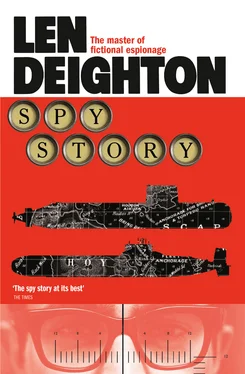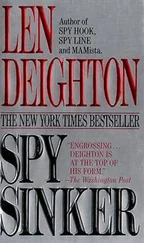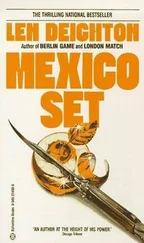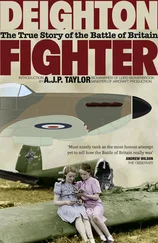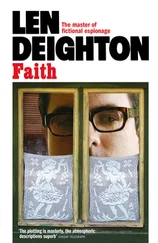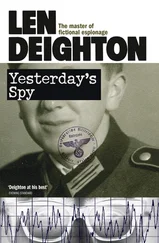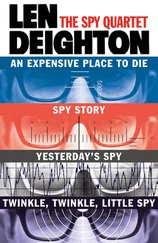This novel is entirely a work of fiction.
The names, characters and incidents portrayed in it are the work of the author’s imagination. Any resemblance to actual persons, living or dead, events or localities is entirely coincidental.
Published by HarperCollins Publishers Ltd 1 London Bridge Street London SE1 9GF
www.harpercollins.co.uk
First published in Great Britain by Jonathan Cape Ltd in 1974
Copyright © Len Deighton 1974
Introduction copyright © Pluriform Publishing Company BV 2012
Cover designer’s note © Arnold Schwartzman 2012
Len Deighton asserts the moral right to be identified as the author of this work
A catalogue record for this book is available from the British Library
All rights reserved under International Copyright Conventions. By payment of the required fees, you have been granted the non-exclusive, non-transferable right to access and read the text of this e-book on-screen. No part of this text may be reproduced, transmitted, down-loaded, decompiled, reverse engineered, or stored in or introduced into any information storage and retrieval system, in any form or by any means, whether electronic or mechanical, now known or hereinafter invented, without the express written permission of HarperCollins e-books.
Ebook Edition © June 2012 ISBN: 9780007458400
Version: 2017-05-23
‘But war’s a game, which, were their subjects wise, Kings would not play at.’
William Cowper, 1731–1800
Table of Contents
Cover
Title Page LEN DEIGHTON Spy Story
Copyright Copyright This novel is entirely a work of fiction. The names, characters and incidents portrayed in it are the work of the author’s imagination. Any resemblance to actual persons, living or dead, events or localities is entirely coincidental. Published by HarperCollins Publishers Ltd 1 London Bridge Street London SE1 9GF www.harpercollins.co.uk First published in Great Britain by Jonathan Cape Ltd in 1974 Copyright © Len Deighton 1974 Introduction copyright © Pluriform Publishing Company BV 2012 Cover designer’s note © Arnold Schwartzman 2012 Len Deighton asserts the moral right to be identified as the author of this work A catalogue record for this book is available from the British Library All rights reserved under International Copyright Conventions. By payment of the required fees, you have been granted the non-exclusive, non-transferable right to access and read the text of this e-book on-screen. No part of this text may be reproduced, transmitted, down-loaded, decompiled, reverse engineered, or stored in or introduced into any information storage and retrieval system, in any form or by any means, whether electronic or mechanical, now known or hereinafter invented, without the express written permission of HarperCollins e-books. Ebook Edition © June 2012 ISBN: 9780007458400 Version: 2017-05-23
Epigraph ‘But war’s a game, which, were their subjects wise, Kings would not play at.’ William Cowper, 1731–1800
Introduction
Chapter 1
Chapter 2
Chapter 3
Chapter 4
Chapter 5
Chapter 6
Chapter 7
Chapter 8
Chapter 9
Chapter 10
Chapter 11
Chapter 12
Chapter 13
Chapter 14
Chapter 15
Chapter 16
Chapter 17
Chapter 18
Chapter 19
Chapter 20
Chapter 21
Acknowledgements
Cover designer’s note
About the Author
By Len Deighton
About the Publisher
I don’t know how or when I became interested in the history of military uniforms but I remember why. It was because John Edgcombe, manager of the Times Bookshop, told me that collectors of model soldiers were the most expert and dedicated group of military enthusiasts he had ever come across. We met on the third Friday of each month in the Tudor Room of Caxton Hall, London SW1. And my first visit there was a revelation. I didn’t know what model soldiers were until I saw these amazing figures, painted with the skill and detail that I had hitherto associated only with the sort of fine miniature paintings on display in museums.
Copies of The Bulletin , the monthly newsletter of The British Model Soldiers Society, alongside those of the associated Military Historical Society (Saturday afternoons at the Imperial War Museum), still fill a shelf in my library and they go back to January 1959. I have never discarded them because they provide a wealth of information not available elsewhere. I never collected or painted model soldiers but I enjoyed those evenings and it was a member of that group who invited me to a naval war game session.
I expected to see a complicated desk game, perhaps something like three-dimensional chess, which was going through a fashionable phase about that time. In the event I went to one of those grim Victorian-period school buildings that are still to be found in south London. It was Saturday morning and the war gamers had taken over the whole premises for the weekend: ‘war doesn’t stop when it gets dark,’ it was explained to me.
One classroom was occupied by the staff of battle group Red. Another held the staff of battle group Blue. A ‘sentry’ was at the door to ensure that a trip to the toilets did not include a chance to glimpse the gymnasium. For on the floor of the gymnasium model ships, drawn up into two battle fleets, were arranged and constantly moved by monitors. Isolated in the upstairs classrooms, the staffs would only be given information that could come from the crow’s nest of their tallest warship.
The staffs were all at sea but for us spectators, standing around the gymnasium, the whole picture was provided. On the stage a row of chairs gave half a dozen ‘referees’ a place to supervise, observe and declare damage or sinking as the engagement progressed.
I was captivated. This was serious stuff and there were not many smiles or jokes. This was war and I had no doubt that many of those involved in this game knew what the real thing was like. I must have been an incongruous figure at these gatherings. I never painted a toy soldier or participated in any of the war games; younger than most of the others, all I did was ask questions. Fortunately most people enjoy answering reasonably sensible questions that test their expertise so I was accepted. Many years later it was that elaborate war game that provided the starting place and background to a book, and it was naval combat that was in my mind.
I am not in a minority as far as my interest in submarines is concerned. Starting with Jules Verne, there have been dozens of books and movies about the men who brave the claustrophobic tin tubes. Submarines have interested me ever since childhood when I discovered that submarines that carried aircraft really did exist. In the Second World War the Japanese navy had many of them. In September 1942 the submarine I-25 launched a seaplane that dropped incendiary bombs on a forest in Oregon and returned safely back to its submarine.
A more bizarre type of submarine was the steam-driven K Class that the Royal Navy used in the First World War. The difficulties and dangers of reconciling diving under water with the capricious machinery of steam engines surprised no one but the men in the Admiralty; and these submarines were a tragic disaster for those assigned to them.
When in January 1955 the submarine USS Nautilus was underway on nuclear power for the first time, it was a triumph for Admiral Hyman Rickover, one of the most important and prescient men of his century. The conversion of ships and civilian power supply to nuclear energy was largely due to him. In 1959 the USS George Washington , a nuclear-powered (and nuclear missile-equipped) submarine, was launched it was followed by the first nuclear-powered warship and the first nuclear-powered merchant ship in that same year. The following year, 1960, the first nuclear-powered aircraft carrier was launched. The coming of the nuclear-powered submarine completely changed naval warfare, and this joined the nuclear-powered aircraft carrier as the major strategic weapon. In this book I have attempted to give a glimpse of what life was like in the nuclear submarines during the Cold War that sometimes became hot, and when some submarines did not return from patrol
Читать дальше
